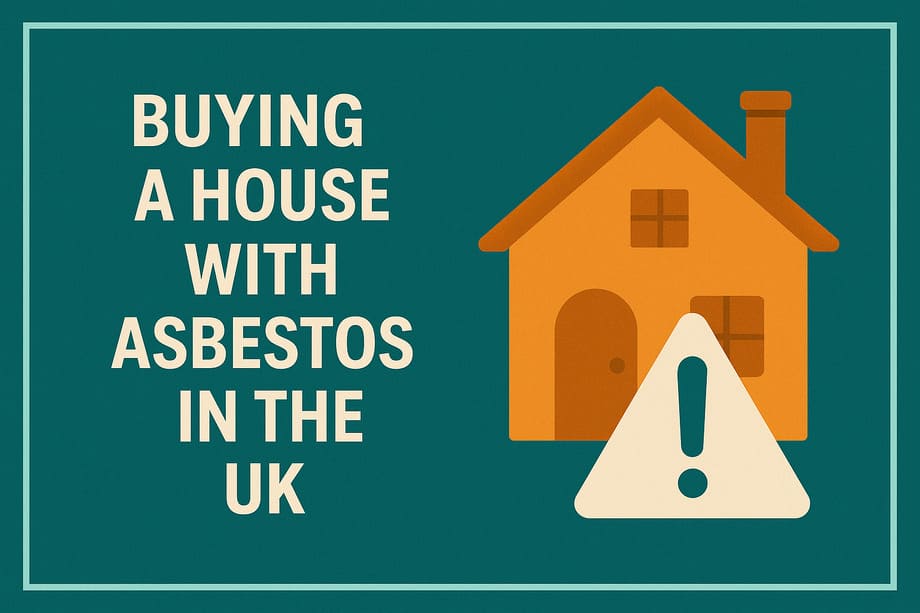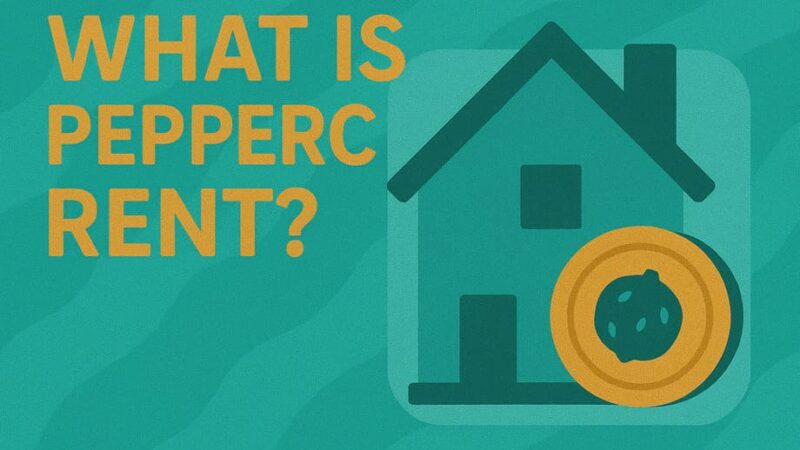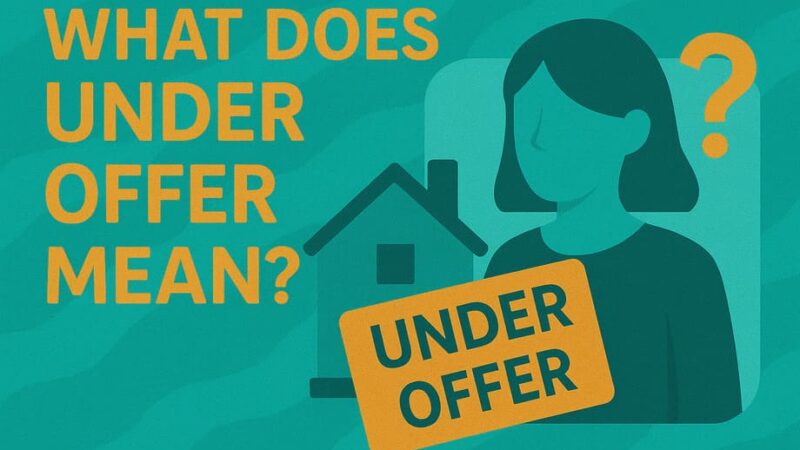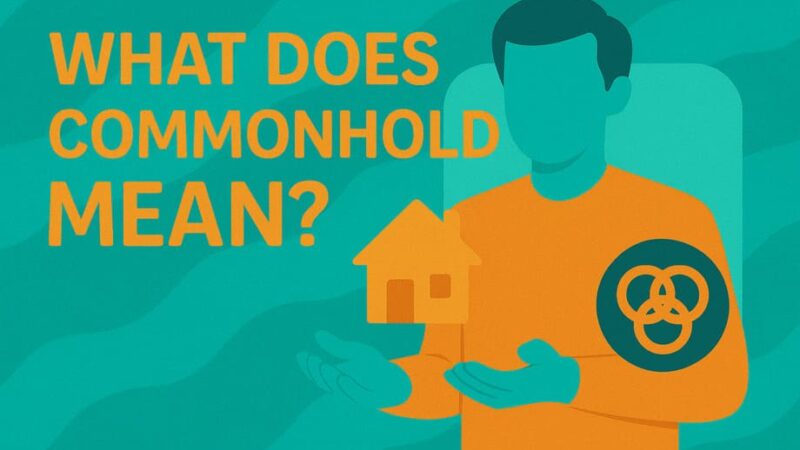Buying A House With Asbestos in the UK

Discovering that the property you’re interested in contains asbestos can feel alarming. The word itself carries frightening connotations, and understandably so given its well-documented health risks. However, buying a house with asbestos doesn’t automatically mean you should walk away from the purchase. With over 1.5 million buildings across the UK containing asbestos, it’s far more common than many buyers realise. This guide explains everything you need to know about buying a house with asbestos, helping you make an informed decision.
What Is Asbestos and Why Was It Used?
Asbestos is a naturally occurring fibrous silicate mineral that was extensively used in UK construction from the 1950s through to 1999. Despite being a natural material, asbestos became incredibly popular in building because of its remarkable properties. It’s fire-resistant, exceptionally strong, an excellent insulator, widely available, and was relatively inexpensive to source and use.
There are actually six different types of asbestos fibres, though the three most commonly used in UK buildings were chrysotile (white asbestos), amosite (brown asbestos), and crocidolite (blue asbestos). White asbestos was by far the most prevalent in UK construction.
The material was considered something of a “magic mineral” during its heyday and was used in countless applications across residential and commercial buildings. It appeared in everything from insulation and roofing materials to decorative coatings and floor tiles.
When Was Asbestos Banned in the UK?
The ban on asbestos happened in stages as understanding of its dangers grew:
- 1985: Blue and brown asbestos were banned from use in the UK
- 1999: White asbestos was finally banned, completing the prohibition
This timeline means that properties built after 2000 are highly unlikely to contain asbestos. However, any property constructed before this date, particularly those built during the 1950s, 1960s, and 1970s when asbestos use peaked—may well contain asbestos materials.
Even after the 1985 ban on blue and brown asbestos, white asbestos continued to be used. For example, Artex textured coatings were still manufactured with white asbestos until the mid-1980s, and asbestos cement products remained common throughout the 1990s.
Where Might You Find Asbestos in a House?
Asbestos was used in numerous locations throughout homes, often in places you wouldn’t immediately think to look. Understanding where asbestos commonly appears helps you assess potential risks when buying a house with asbestos.
Inside the Property
Common internal locations include:
- Textured coatings: Artex and similar decorative ceiling coatings applied in the 1970s and 1980s typically contain 1-4% asbestos
- Insulation: Around boilers, pipes (pipe lagging), and within airing cupboards
- Ceiling tiles: Asbestos insulating board ceiling tiles were particularly popular in the 1950s and 1960s
- Floor tiles: Vinyl floor tiles and their backing adhesive often contained asbestos
- Bathroom fittings: Bath panels, toilet cisterns, and backing boards
- Electrical fittings: Behind fuse boxes and around electrical installations
- Water tanks: Asbestos cement water tanks in lofts
- Partition walls: Asbestos insulating board used in internal walls
- Around fireplaces: Backing boards behind fires and hearths
- Loose fill insulation: In lofts and cavity walls
Outside the Property
External locations where asbestos commonly appears:
- Roofing materials: Asbestos cement roof tiles, slates, and corrugated sheeting
- Soffits and fascias: Asbestos cement or asbestos insulating board
- Guttering and downpipes: Asbestos cement rainwater goods
- Wall panels: Asbestos cement cladding and external panels
- Garage roofs: Corrugated asbestos cement sheets
- Sheds and outbuildings: Asbestos cement construction materials
The key point is that asbestos could be present in multiple locations throughout any pre-2000 property. You cannot determine whether materials contain asbestos simply by looking at them—laboratory testing is the only reliable method.
Understanding the Health Risks
The serious health implications of asbestos are now well established. When asbestos-containing materials are disturbed or damaged, microscopic fibres are released into the air. If these fibres are inhaled, they can cause severe health conditions including:
- Mesothelioma: An incurable cancer affecting the lining of the lungs, abdomen, or heart
- Asbestosis: Progressive scarring of the lungs causing breathing difficulties and increased cancer susceptibility
- Lung cancer: Significantly elevated risk among those exposed to asbestos fibres
- Other respiratory diseases: Various breathing problems and lung conditions
What makes asbestos particularly insidious is the latency period. Health problems typically don’t appear immediately after exposure. Instead, symptoms often emerge 20 to 40 years later, by which time the damage is already done and largely irreversible.
When Is Asbestos Dangerous?
Here’s the crucial point that many buyers misunderstand: asbestos in good condition that remains undisturbed is relatively safe. According to the Health and Safety Executive, asbestos only becomes a significant health risk when it’s released into the air and breathed in.
Asbestos becomes dangerous when:
- Materials are drilled, sawed, sanded, or otherwise worked on
- Asbestos-containing materials deteriorate or become damaged
- Items are demolished or removed without proper precautions
- Surfaces are scraped or disturbed during renovation
Conversely, asbestos that’s sealed, encapsulated, or simply left alone in stable condition presents minimal risk. This is why many properties continue to have asbestos present that doesn’t require immediate action.
Should You Buy a House With Asbestos?
The presence of asbestos shouldn’t automatically disqualify a property from consideration. Asbestos is remarkably common in UK homes, approximately 50% of properties contain it to some degree. Walking away from every property with asbestos would eliminate half the housing market from your search.
Factors to Consider
When deciding whether to proceed with buying a house with asbestos, consider:
Condition of the Asbestos: If asbestos materials are in good condition, stable, and unlikely to be disturbed, they may not require immediate attention. The risk level is significantly lower for well-maintained, intact asbestos.
Your Plans for the Property: If you’re planning extensive renovations, extensions, or alterations, asbestos becomes a more significant concern. Any work that might disturb asbestos materials requires proper management and potentially costly professional removal.
Location of the Asbestos: Asbestos in accessible areas where it might be accidentally damaged (like hallway ceilings) presents more risk than asbestos in inaccessible locations (like behind fixed panels or within roof structures).
Type and Amount: Some types of asbestos are more hazardous than others, and the total quantity present affects both risk and removal costs.
Your Risk Tolerance: Some buyers are comfortable managing asbestos presence, whilst others prefer to avoid it entirely. Your personal comfort level matters.
Financial Implications: Consider removal or encapsulation costs, potential mortgage complications, and the impact on resale value.
Think of asbestos like outdated wiring in a property. It’s not ideal and potentially dangerous if not managed properly, but it can be dealt with. A wise buyer factors asbestos into their offer price rather than automatically rejecting the property.
Getting an Asbestos Survey
If you’re considering buying a house that was built before 2000, arranging an asbestos survey provides clarity about what you’re dealing with. Standard homebuyer surveys or building surveys are not specialist asbestos reports. While surveyors may note the potential presence of asbestos based on their experience, they don’t conduct laboratory testing.
Types of Asbestos Surveys
There are two main types of asbestos surveys:
Management Survey: This is the standard survey used to locate and assess the condition of asbestos-containing materials that could be damaged during normal occupancy. It’s less intrusive and focuses on accessible areas.
Refurbishment and Demolition Survey: This more comprehensive survey is required before any refurbishment or demolition work. It’s fully intrusive and aims to locate all asbestos-containing materials in the areas where work will take place.
For buying a house with asbestos, a management survey is typically appropriate unless you’re planning immediate major renovations.
What Happens During an Asbestos Survey
An asbestos surveyor visits the property wearing protective clothing and equipment. They conduct a thorough inspection, taking samples of suspected asbestos-containing materials. These samples are sent to a UKAS-accredited laboratory for testing.
You’ll receive a detailed report stating:
- Which materials contain asbestos
- The type of asbestos present
- The condition of the materials
- Risk assessments for each location
- Recommendations for management or removal
- Estimated costs for any required work
Choosing an Asbestos Surveyor
When selecting a surveyor, ensure they have:
- Appropriate qualifications (typically BOHS P402 and P405)
- Accreditation to standard BS EN ISO/IEC 17020
- UKAS accreditation (the only accreditation recognized by the HSE in the UK)
- Suitable experience and professional indemnity insurance
Asbestos Survey Costs
An asbestos survey for a 2-3 bedroom house typically costs around £250, though prices vary based on property size, age, and complexity. This is a worthwhile investment that provides certainty before committing to purchase.
Mail-in testing kits cost £50-£180, on-site inspections range from £230-£780, and comprehensive air monitoring costs £300-£1,200.
Dealing With Asbestos: Your Options
Once you know asbestos is present, you have several options for managing it.
Leave It Undisturbed
If asbestos materials are in good condition and unlikely to be damaged, the safest and most cost-effective option is often to leave them alone. Monitor their condition periodically to ensure they haven’t deteriorated, but otherwise, simply avoid disturbing them.
This approach works well for:
- Asbestos in inaccessible locations
- Materials in excellent condition
- Situations where renovation isn’t planned
- When budgets are tight
Encapsulation
Encapsulation involves sealing asbestos materials with special coatings or coverings that prevent fibres from being released. This costs approximately £25 per square metre, significantly less than removal and can be an effective long-term solution.
Encapsulation works by creating a protective barrier over the asbestos. It’s particularly suitable for textured coatings like Artex, where the asbestos content is relatively low and the material is otherwise in decent condition.
Professional Removal
Complete removal eliminates the asbestos risk entirely but is the most expensive option, averaging around £150 per square metre. Total costs depend on:
- The amount of asbestos present
- The type of asbestos
- Its location and accessibility
- The condition of the materials
- Local authority disposal fees
Professional removal is necessary when:
- Asbestos materials are badly damaged or deteriorating
- You’re planning renovations that would disturb the asbestos
- The asbestos is in a high-risk location
- You want complete peace of mind
Removal typically requires the property to be vacated for 24-48 hours whilst contractors work in full protective equipment within sealed areas. All asbestos waste must be disposed of at licensed facilities.
Never attempt DIY asbestos removal. The UK Health Security Agency strongly advises against it, and improper removal can create far greater risks than leaving undisturbed asbestos in place.
Negotiating the Purchase Price
Discovering asbestos during the buying process gives you legitimate grounds to renegotiate the purchase price. The costs of dealing with asbestos can be substantial, and these should be reflected in what you pay.
Calculating Fair Adjustments
To determine a reasonable price reduction:
- Obtain quotes for professional removal or encapsulation
- Factor in the inconvenience and time required for remediation
- Consider the impact on your renovation plans
- Account for any mortgage valuation issues
- Include contingency for unexpected discoveries
If removal will cost £5,000, requesting a £5,000-£7,500 price reduction accounts for both the direct costs and the hassle involved.
Negotiation Strategies
- Present the asbestos survey report as evidence
- Obtain multiple quotes from licensed asbestos removal contractors
- Be prepared to walk away if the seller won’t negotiate fairly
- Consider requesting the seller arranges removal before completion
- Use asbestos as leverage alongside other survey findings
Remember that sellers are legally obliged to disclose known asbestos presence. If they didn’t mention it initially, you have strong negotiating power.
Mortgage and Insurance Considerations
Buying a house with asbestos can affect both mortgage approval and insurance, though the impact varies considerably.
Getting a Mortgage
Most lenders will provide mortgages for properties with asbestos, but there are considerations:
- Lenders may require a specialist asbestos survey beyond the standard valuation
- Some lenders won’t lend on properties with extensive asbestos or poor-condition materials
- Asbestos roofs are generally less problematic for lenders than asbestos integral to the building structure
- You may need to demonstrate a management plan for the asbestos
- Properties requiring imminent asbestos removal may be deemed unmortgageable until work is completed
The key is the condition and extent of the asbestos. A roof with asbestos cement tiles in good condition rarely prevents mortgage approval. Extensive asbestos insulation in poor condition throughout the property is more likely to cause lender concerns.
Home Insurance
Standard home insurance policies typically don’t cover routine asbestos removal as it’s considered a maintenance issue. However:
- Buildings insurance may cover asbestos removal necessitated by insured events (like storm or fire damage)
- The presence of asbestos generally doesn’t need to be disclosed to insurers
- Asbestos presence shouldn’t affect insurance premiums
- Properties with asbestos are insurable under standard buildings and contents policies
Legal Obligations and Disclosure
Seller Responsibilities
If sellers know asbestos is present in their property, they must declare it to potential buyers. The Property Misdescriptions Act 2013 makes it an offence to withhold this information. Failing to disclose known asbestos could:
- Invalidate the sale
- Result in legal action from the buyer
- Lead to prosecution
- Create liability for any health issues
However, if sellers genuinely don’t know asbestos is present, they have no liability. This is why many sellers arrange their own asbestos surveys before marketing properties—it eliminates uncertainty and demonstrates transparency.
Buyer Rights
As a buyer:
- You have the right to conduct your own asbestos survey
- Sellers must provide copies of any existing asbestos surveys
- You can use survey findings to renegotiate the price
- You’re not legally obligated to remove asbestos after purchase
- You must disclose asbestos to anyone who might be at risk from exposure during any work
Leasehold and Shared Ownership
If buying a leasehold flat or shared ownership property, asbestos in communal areas (staircases, landings, corridors) is typically the landlord’s or management company’s responsibility under Health and Safety Executive duty to manage regulations.
However, asbestos within your individual flat remains your private responsibility. When buying a leasehold freehold or taking ownership of communal areas, you inherit responsibility for any asbestos present, making pre-purchase surveys particularly important.
Special Consideration: Artex
Artex deserves specific mention as it’s one of the most common asbestos-containing materials buyers encounter. This textured decorative coating was immensely popular throughout the 1970s and early 1980s for creating stippled or geometric patterns on ceilings and walls.
Artex manufactured before the mid-1980s commonly contains 1-4% white asbestos. The relatively low percentage doesn’t make it safe to disturb drilling, scraping, or sanding Artex releases hazardous fibres.
Not all Artex contains asbestos, as manufacturers stopped including it after the ban. Unfortunately, you cannot determine whether Artex contains asbestos by visual inspection. The only way to know is through laboratory testing of samples taken by a qualified surveyor.
If buying a house with Artex:
- Assume it contains asbestos unless testing proves otherwise
- Factor testing and potential removal costs into your offer
- Consider whether you can live with the Artex in place
- Explore encapsulation options if removal seems too expensive
- Never attempt DIY removal of suspected asbestos Artex
Impact on Property Value
Asbestos can affect property values, though the impact depends on several factors:
- Minimal Impact: Properties with small amounts of asbestos in good condition typically see little to no value reduction
- Moderate Impact: Properties with more extensive asbestos might see 5-10% value reductions
- Significant Impact: Properties requiring major asbestos remediation could see 10-15% reductions or more
The actual impact depends on:
- Local market conditions
- Buyer attitudes and awareness
- The property’s overall condition and desirability
- Location and extent of asbestos
- Estimated removal costs
Some properties with asbestos sell for full market value, particularly when sellers have obtained surveys and provided management plans, demonstrating transparency and responsibility.
Can Asbestos Stop a Sale?
Yes, asbestos can potentially stop a property sale, though it doesn’t always. Sales fall through because of asbestos when:
- Extensive asbestos in poor condition makes the property unmortgageable
- Buyers fear health risks despite professional reassurance
- Removal costs are prohibitively expensive relative to property value
- Buyers are planning renovations that would be complicated by asbestos
- Lenders refuse to provide mortgages without remediation
However, many sales proceed successfully despite asbestos presence. Transparency, proper surveys, and realistic pricing overcome most buyer concerns.
Making Your Decision
Buying a house with asbestos requires careful consideration but shouldn’t be automatically rejected. Weigh these factors:
Proceed with the purchase if:
- Asbestos is minimal and in good condition
- Professional surveys indicate low risk
- You’re not planning major renovations
- The price reflects asbestos-related costs
- You can obtain mortgage approval
- You’re comfortable with proper asbestos management
Reconsider if:
- Extensive asbestos throughout the property is in poor condition
- Major renovations would require costly removal
- Mortgage approval seems unlikely
- Removal costs would make the purchase uneconomical
- You’re uncomfortable with any level of asbestos risk
Frequently Asked Questions About Buying A House With Asbestos
Should I walk away from buying a house with asbestos?
Not necessarily. Asbestos in good condition that won’t be disturbed presents minimal risk. Consider the condition, location, your renovation plans, and removal costs before deciding. Many properties with asbestos sell successfully and provide good homes.
How do I know if a house has asbestos?
Properties built before 2000 may contain asbestos. You cannot identify asbestos visually only laboratory testing confirms its presence. Arrange an asbestos survey with a UKAS-accredited surveyor for certainty.
Is it illegal to sell a house with asbestos?
No, selling a house with asbestos is perfectly legal in the UK. However, sellers must disclose known asbestos presence to buyers. Failure to disclose known asbestos is illegal under the Property Misdescriptions Act 2013.
Can I get a mortgage on a house with asbestos?
Yes, most lenders will provide mortgages for properties with asbestos, provided it’s not extensive or in poor condition. Some lenders may require additional surveys or evidence of management plans. Asbestos roofs in good condition rarely prevent mortgage approval.
How much does asbestos removal cost?
Asbestos removal costs average around £150 per square metre, though total costs vary based on the amount, type, location, and accessibility of asbestos. Removal for a typical house might range from £1,500-£5,000 or more for extensive asbestos. Encapsulation costs around £25 per square metre.
Does home insurance cover asbestos removal?
Standard home insurance typically doesn’t cover routine asbestos removal as it’s considered maintenance. Insurance might cover removal if asbestos materials are damaged by an insured event like fire or storm. Check your specific policy terms.
Should I remove asbestos before selling my house?
Not necessarily. If asbestos is in good condition, removal before sale may not be necessary. However, having asbestos professionally surveyed and providing documentation to potential buyers demonstrates transparency and can facilitate sales. Consider removing only badly damaged asbestos.
What if I find asbestos after buying?
If you discover asbestos after purchase that wasn’t disclosed and the seller knew about it, you may have legal recourse. If the seller genuinely didn’t know, your options are limited. Have it professionally assessed and create a management plan. Leave undisturbed asbestos alone if it’s in good condition.
Final Thoughts on Buying A House With Asbestos
Buying a house with asbestos doesn’t need to be a deal-breaker. While the word “asbestos” understandably causes concern, the reality is that millions of UK properties contain asbestos that’s being safely managed or simply left undisturbed without issue.
The key to making a sound decision is information. Arrange professional surveys, understand exactly what asbestos is present and where, assess the condition accurately, and obtain realistic cost estimates for any required work. Armed with this knowledge, you can negotiate fairly and make an informed choice about whether to proceed.
Remember that asbestos in stable, good condition isn’t an immediate health threat. It only becomes dangerous when disturbed or damaged. Many homeowners live in properties with asbestos for years without problems, simply by avoiding disturbing it and monitoring its condition.
If you’re planning extensive renovations, asbestos becomes a more significant consideration requiring professional removal. But if you’re buying a move-in ready property where asbestos materials won’t be disturbed, the risks are minimal.
Use asbestos discovery as a negotiating tool to achieve a fair price that reflects any costs you’ll incur. Don’t let fear alone drive your decision let facts, professional advice, and careful cost analysis guide you. With the right approach, buying a house with asbestos can still lead to a successful purchase and a happy home.
Last Updated on October 16, 2025 by James Cartwright







